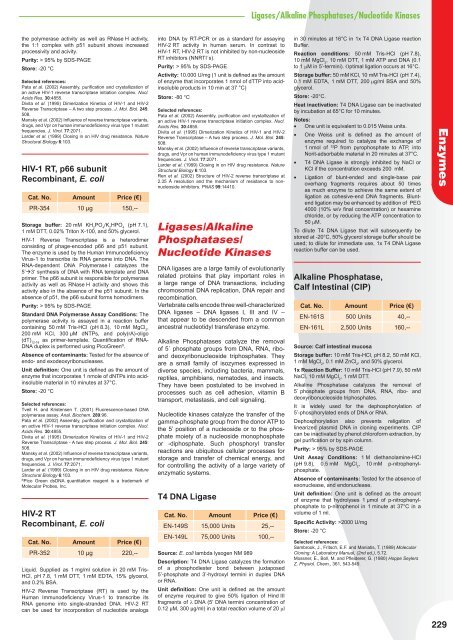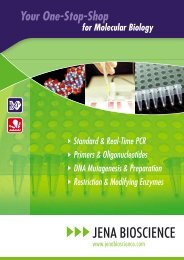Nucleotide Analogs - Jena Bioscience
Nucleotide Analogs - Jena Bioscience
Nucleotide Analogs - Jena Bioscience
Create successful ePaper yourself
Turn your PDF publications into a flip-book with our unique Google optimized e-Paper software.
the polymerase activity as well as RNase H activity,<br />
the 1:1 complex with p51 subunit shows increased<br />
processivity and acivity.<br />
Purity: > 95% by SDS-PAGE.<br />
Store: -20 °C<br />
Selected references:<br />
Pata et al. (2002) Assembly, purifi cation and crystallization of<br />
an active HIV-1 reverse transcriptase initiation complex. Nucl.<br />
Acids Res. 30:4855.<br />
Divita et al. (1995) Dimerization Kinetics of HIV-1 and HIV-2<br />
Reverse Transcriptase – A two step process. J. Mol. Biol. 245:<br />
508.<br />
Mansky et al. (2002) Infl uence of reverse transcriptase variants,<br />
drugs, and Vpr on human immunodefi ciency virus type 1 mutant<br />
frequencies. J. Virol. 77:2071.<br />
Larder et al. (1999) Closing in on HIV drug resistance. Nature<br />
Structural Biology 6:103.<br />
HIV-1 RT, p66 subunit<br />
Recombinant, E. coli<br />
Cat. No. Amount Price (€)<br />
PR-354 10 µg 150,--<br />
Storage buffer: 20 mM KH PO /K HPO (pH 7.1),<br />
2 4 2 4<br />
1 mM DTT, 0.02% Triton X-100, and 50% glycerol.<br />
HIV-1 Reverse Transcriptase is a heterodimer<br />
consisting of phage-encoded p66 and p51 subunit.<br />
The enzyme is used by the Human Immunodefi ciency<br />
Virus-1 to transcribe its RNA genome into DNA. The<br />
RNA-dependent DNA Polymerase I catalyzes the<br />
5’�3‘ synthesis of DNA with RNA template and DNA<br />
primer. The p66 subunit is responsible for polymerase<br />
activity as well as RNase H activity and shows this<br />
activity also in the absence of the p51 subunit. In the<br />
absence of p51, the p66 subunit forms homodimers.<br />
Purity: > 95% by SDS-PAGE.<br />
Standard DNA Polymerase Assay Conditions: The<br />
polymerase activity is assayed in a reaction buffer<br />
containing 50 mM Tris-HCl (pH 8.3), 10 mM MgCl , 2<br />
200 mM KCl, 300 µM dNTPs, and poly(rA)-oligo<br />
(dT) as primer-template. Quantifi cation of RNA-<br />
12-18<br />
DNA duplex is performed using PicoGreen ® .<br />
Absence of contaminants: Tested for the absence of<br />
endo- and exodeoxyribonucleases.<br />
Unit defi nition: One unit is defi ned as the amount of<br />
enzyme that incorporates 1 nmole of dNTPs into acidinsoluble<br />
material in 10 minutes at 37°C.<br />
Store: -20 °C<br />
Selected references:<br />
Tveit H. and Kristensen T. (2001) Fluorescence-based DNA<br />
polymerase assay. Anal. Biochem. 289:96.<br />
Pata et al. (2002) Assembly, purifi cation and crystallization of<br />
an active HIV-1 reverse transcriptase initiation complex. Nucl.<br />
Acids Res. 30:4855.<br />
Divita et al. (1995) Dimerization Kinetics of HIV-1 and HIV-2<br />
Reverse Transcriptase - A two step process. J. Mol. Biol. 245:<br />
508.<br />
Mansky et al. (2002) Infl uence of reverse transcriptase variants,<br />
drugs, and Vpr on human immunodefi ciency virus type 1 mutant<br />
frequencies. J. Virol. 77:2071.<br />
Larder et al. (1999) Closing in on HIV drug resistance. Nature<br />
Structural Biology 6:103.<br />
® Pico Green dsDNA quantitation reagent is a trademark of<br />
Molecular Probes, Inc.<br />
HIV-2 RT<br />
Recombinant, E. coli<br />
Cat. No. Amount Price (€)<br />
PR-352 10 µg 220,--<br />
Liquid. Supplied as 1 mg/ml solution in 20 mM Tris-<br />
HCl, pH 7.8, 1 mM DTT, 1 mM EDTA, 15% glycerol,<br />
and 0.2% BSA.<br />
HIV-2 Reverse Transcriptase (RT) is used by the<br />
Human Immunodefi ciency Virus-1 to transcribe its<br />
RNA genome into single-stranded DNA. HIV-2 RT<br />
can be used for incorporation of nucleotide analogs<br />
into DNA by RT-PCR or as a standard for assaying<br />
HIV-2 RT activity in human serum. In contrast to<br />
HIV-1 RT, HIV-2 RT is not inhibited by non-nucleoside<br />
RT inhibitors (NNRTI´s).<br />
Purity: > 95% by SDS-PAGE.<br />
Activity: 10.000 U/mg (1 unit is defi ned as the amount<br />
of enzyme that incorporates 1 nmol of dTTP into acidinsoluble<br />
products in 10 min at 37 °C)<br />
Store: -80 °C<br />
Selected references:<br />
Pata et al. (2002) Assembly, purifi cation and crystallization of<br />
an active HIV-1 reverse transcriptase initiation complex. Nucl.<br />
Acids Res. 30:4855.<br />
Divita et al. (1995) Dimerization Kinetics of HIV-1 and HIV-2<br />
Reverse Transcriptase – A two step process. J. Mol. Biol. 245:<br />
508.<br />
Mansky et al. (2002) Infl uence of reverse transcriptase variants,<br />
drugs, and Vpr on human immunodefi ciency virus type 1 mutant<br />
frequencies. J. Virol. 77:2071.<br />
Larder et al. (1999) Closing in on HIV drug resistance. Nature<br />
Structural Biology 6:103.<br />
Ren et al. (2002) Structure of HIV-2 reverse transcriptase at<br />
2.35 Å resolution and the mechanism of resistance to nonnucleoside<br />
inhibitors. PNAS 99:14410.<br />
Ligases/Alkaline<br />
Phosphatases/<br />
<strong>Nucleotide</strong> Kinases<br />
DNA ligases are a large family of evolutionarily<br />
related proteins that play important roles in<br />
a large range of DNA transactions, including<br />
chromosomal DNA replication, DNA repair and<br />
recombination.<br />
Vertebrate cells encode three well-characterized<br />
DNA ligases – DNA ligases I, III and IV –<br />
that appear to be descended from a common<br />
ancestral nucleotidyl transferase enzyme.<br />
Alkaline Phosphatases catalyze the removal<br />
of 5` phosphate groups from DNA, RNA, ribo-<br />
and deoxyribonucleoside triphosphates. They<br />
are a small family of isozymes expressed in<br />
diverse species, including bacteria, mammals,<br />
reptiles, amphibians, nematodes, and insects.<br />
They have been postulated to be involved in<br />
processes such as cell adhesion, vitamin B<br />
transport, metastasis, and cell signaling.<br />
<strong>Nucleotide</strong> kinases catalyze the transfer of the<br />
gamma-phosphate group from the donor ATP to<br />
the 5’ position of a nucleoside or to the phosphate<br />
moiety of a nucleoside monophosphate<br />
or -diphosphate. Such phosphoryl transfer<br />
reactions are ubiquitous cellular processes for<br />
storage and transfer of chemical energy, and<br />
for controlling the activity of a large variety of<br />
enzymatic systems.<br />
T4 DNA Ligase<br />
Cat. No. Amount Price (€)<br />
EN-149S 15,000 Units 25,--<br />
EN-149L 75,000 Units 100,--<br />
Source: E. coli lambda lysogen NM 989<br />
Description: T4 DNA Ligase catalyzes the formation<br />
of a phosphodiester bond between juxtaposed<br />
5’-phosphate and 3’-hydroxyl termini in duplex DNA<br />
or RNA.<br />
Unit defi nition: One unit is defi ned as the amount<br />
of enzyme required to give 50% ligation of Hind III<br />
fragments of λ DNA (5’ DNA termini concentration of<br />
0.12 µM, 300 µg/ml) in a total reaction volume of 20 µl<br />
Ligases/Alkaline Phosphatases/<strong>Nucleotide</strong> Kinases<br />
in 30 minutes at 16°C in 1x T4 DNA Ligase reaction<br />
Buffer.<br />
Reaction conditions: 50 mM Tris-HCl (pH 7.8),<br />
10 mM MgCl , 10 mM DTT, 1 mM ATP and DNA (0.1<br />
2<br />
to 1 µM in 5’-termini). Οptimal ligation occurs at 16°C.<br />
Storage buffer: 50 mM KCl, 10 mM Tris-HCl (pH 7.4),<br />
0.1 mM EDTA, 1 mM DTT, 200 µg/ml BSA and 50%<br />
glycerol.<br />
Store: -20°C.<br />
Heat inactivation: T4 DNA Ligase can be inactivated<br />
by incubation at 65°C for 10 minutes.<br />
Notes:<br />
• One unit is equivalent to 0.015 Weiss units.<br />
• One Weiss unit is defi ned as the amount of<br />
enzyme required to catalyze the exchange of<br />
1 nmol of 32P from pyrophosphate to ATP, into<br />
Norit-adsorbable material in 20 minutes at 37°C.<br />
• T4 DNA Ligase is strongly inhibited by NaCl or<br />
KCl if the concentration exceeds 200 mM.<br />
• Ligation of blunt-ended and single-base pair<br />
overhang fragments requires about 50 times<br />
as much enzyme to achieve the same extent of<br />
ligation as cohesive-end DNA fragments. Bluntend<br />
ligation may be enhanced by addition of PEG<br />
4000 (10% w/v fi nal concentration) or hexamine<br />
chloride, or by reducing the ATP concentration to<br />
50 µM.<br />
To dilute T4 DNA Ligase that will subsequently be<br />
stored at -20°C, 50% glycerol storage buffer should be<br />
used; to dilute for immediate use, 1x T4 DNA Ligase<br />
reaction buffer can be used.<br />
Alkaline Phosphatase,<br />
Calf Intestinal (CIP)<br />
Cat. No. Amount Price (€)<br />
EN-161S 500 Units 40,--<br />
EN-161L 2,500 Units 160,--<br />
Source: Calf intestinal mucosa<br />
Storage buffer: 10 mM Tris-HCl, pH 8.2, 50 mM KCl,<br />
1 mM MgCl , 0.1 mM ZnCl , and 50% glycerol.<br />
2 2<br />
1x Reaction Buffer: 10 mM Tris-HCl (pH 7.9), 50 mM<br />
NaCl, 10 mM MgCl , 1 mM DTT.<br />
2<br />
Alkaline Phosphatase catalyzes the removal of<br />
5` phosphate groups from DNA, RNA, ribo- and<br />
deoxyribonucleoside triphosphates.<br />
It is widely used for the dephosphorylation of<br />
5’-phosphorylated ends of DNA or RNA.<br />
Dephosphorylation also prevents religation of<br />
linearized plasmid DNA in cloning experiments. CIP<br />
can be inactivated by phenol:chloroform extraction, by<br />
gel purifi cation or by spin column.<br />
Purity: > 95% by SDS-PAGE.<br />
Unit Assay Conditions: 1 M diethanolamine-HCl<br />
(pH 9.8), 0.5 mM MgCl , 10 mM p-nitrophenyl-<br />
2<br />
phosphate.<br />
Absence of contaminants: Tested for the absence of<br />
exonuclease, and endonuclease.<br />
Unit defi nition: One unit is defi ned as the amount<br />
of enzyme that hydrolyses 1 µmol of p-nitrophenylphosphate<br />
to p-nitrophenol in 1 minute at 37°C in a<br />
volume of 1 ml.<br />
Specifi c Activity: >2000 U/mg<br />
Store: -20 °C<br />
Selected references:<br />
Sambrook, J., Fritsch, E.F. and Maniatis, T. (1989) Molecular<br />
Cloning: A Laboratory Manual, (2nd ed,), 5.72.<br />
Mossner, E., Boll, M. and Pfl eiderer, G. (1980) Hoppe Seylers<br />
Z. Physiol. Chem., 361, 543-549.<br />
Enzymes<br />
229



